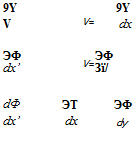VELOCITY POTENTIAL OF AN IRROTATIONAL FIELD
If the velocity vector can be derived from the gradient of a scalar function Ф:
![]() u = УФ
u = УФ
then the flow field is irrotational,
У X u = 0 (i. e., curl u = 0) (2)
since У X УФ = 0 is an identity for any scalar function Ф. The function Ф is called the velocity potential of the flow field.
If the fluid is incompressible, the equation of continuity
![]()
![]() Эи,-
Эи,-
Эх,
which is the equation governing Ф for an incompressible fluid.
According to § 12.2, in thin airfoil theory the flow outside the airfoil and its wake is irrotational and the velocity potential exists.
12.1 COMPLEX POTENTIAL IN TWO-DIMENSIONAL IRROTATIONAL FLOW OF AN INCOMPRESSIBLE FLUID
In a two-dimensional flow in the x, у plane, the velocity has two components u, v in the x and у direction, respectively. If the fluid is incompressible, the equation of continuity
![]() Эм Эи дх ^ Эу
Эм Эи дх ^ Эу
can be satisfied identically if m, v are derived from an arbitrary function Y so that
The function Y is called a stream function. The reason for this name follows the definition of a streamline, which is a curve the tangent of which is everywhere parallel to the local velocity vector. Thus a streamline is defined by the equation.
Thus, along a streamline, Y(a:, y) is a constant. Conversely, every constant defines a streamline
Y(x, y) = const (5)
If, in addition to being incompressible, the flow is irrotational, then
![]()
![]() Э и dv
Э и dv
dy dx
Substituting Eqs. 2, we see that
3aY 9aY dx2 dy2
Thus, for an irrotational incompressible flow, both the velocity potential and the stream function satisfy the Laplace equation.
By definitions of the velocity potential Ф and the stream function Y, we have

![]()
 и
и
Hence,
9Y
dy
which shows that the streamlines (Y = const) and the potential lines (Ф = const) are orthogonal to each other.
Equations 9 are the Cauchy-Riemann differential equations of a function of a complex variable. If W(z) = Ф + /’Y is an analytic function of a complex variable z = x + jy, then Eqs. 9 are satisfied. Conversely, if Eqs. 9 are satisfied, and if the partial derivatives are continuous in a region, then there exists a function W(z) = Ф + у Y which is analytic
in that region. In other words, the velocity potential and the stream function are the real and imaginary parts of an analytic function. Furthermore, the real or imaginary part of any arbitrary analytic function can be taken as a velocity potential or a stream function. Ф and Y are said to be conjugate to each other, so that still another way of stating the above fact is that, to every solution of the Laplace equation,
V2<£ = 0
there corresponds a conjugate function Y(a;, у) satisfying the same equation, and that the system of curves Ф = const and Y = const are orthogonal.
In some occasions, Ф may be associated with other physical quantities, such as an acceleration potential or pressure. The corresponding conjugate function Y may not have an apparent physical meaning, but it serves as a useful medium in the analysis.
The derivatives of the complex potential W(z) — Ф + y’Y has a simple interpretation. Since
![]() dW _ ЭФ,3Y_ dz dx ^ dx
dW _ ЭФ,3Y_ dz dx ^ dx
when Ф is interpreted as a velocity potential, dW/dz is the image in the x axis of the velocity vector ux + ]uv. Hence, dWjdz is often called a complex velocity function.











